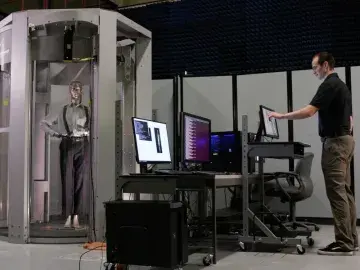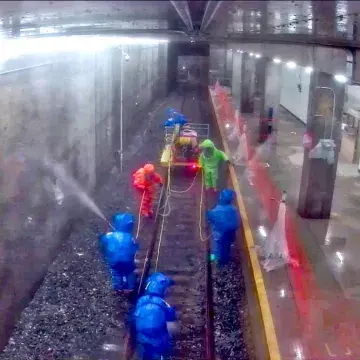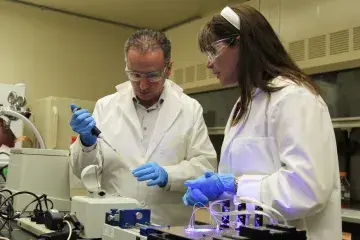A look at how S&T’s five labs—and collaboration with the Department of Energy’s 17 labs—have shaped two decades of research and development innovation.

In a relay race, a team of individual runners must have the necessary talent and preparation to work together smoothly to cross the finish line first. Similarly, in the field of homeland security research, a well-coordinated network of scientific experts can seamlessly share the knowledge and resources necessary to achieve a mission goal or produce a solution that saves lives. At the Science and Technology Directorate (S&T), we can’t think of a better-assembled relay team to do the science than what exists across our coordinated network of national laboratories.
Way back at the starting line when the Department of Homeland Security (DHS) was formed in the aftermath of 9/11, S&T was created alongside it. Over the last 20 years, S&T has continuously carried the baton, preparing and protecting the nation against manmade and natural disasters through investments in science and technology. A big part of S&T’s success comes from its investment in—and collaboration with—the country’s preeminent national laboratories. From the start, researchers at S&T’s own national labs and our counterparts at the Department of Energy’s (DOE) National Laboratories have led the charge to support the DHS mission.
S&T and the Department of Energy, a special partnership
The initial seeds of the partnership with the DOE National Laboratories grew from section 309 of the Homeland Security Act (HSA) of 2002. The goal: support DHS missions by developing a network of interconnected laboratories that work toward solving difficult, multidisciplinary and crosscutting technology challenges. As DHS was stood up, many DOE staff were detailed to S&T to establish it as an organization primed to do the science. Congress also used the HSA to streamline DHS’ access to DOE’s world-class lab capabilities and allowed S&T to work in lockstep with our DOE colleagues to support the homeland security mission.

The DOE labs are government-owned, contractor-operated, federally-funded research and development centers offering capabilities aligned with the DHS mission. The laboratories’ extensive science and technology expertise is at the forefront of basic research in many homeland security areas, but do not overlap with S&T’s labs or the direct mission support they provide. Rather, the DOE National Laboratories complement the applied research and test and evaluation activities that are a primary focus of S&T’s in-house national labs. This dynamic has produced savings in both resources and time and has helped DHS to deter and defeat homeland security threats in an effective, efficient and secure way. The research that the DOE National Laboratories have performed in partnership with S&T through the years explores a wide range of critical areas, such as big data, radiological/nuclear response, severe weather, critical infrastructure and cybersecurity.
To stay on the cutting-edge of the homeland security mission, S&T’s and DOE’s science and technology vision continuously evolves. As the threat landscape changes, S&T remains vigilant, looking for vulnerabilities, addressing them with new research questions, and assessing current capabilities to improve or replace them with stronger ones.
The substantial investments made by the DOE National Laboratories in basic research—looking at fundamental scientific problems and making discoveries without specific applications—presents prime opportunities for S&T to align that science to an identified homeland security need or application, which can then produce important mission impacts. The potential in these “handoffs” is a hallmark of the special partnership.
“Our job is not necessarily to decide what the DOE labs should do or how a program should be run,” said Julie Brewer, executive director of S&T’s Office of Innovation and Collaboration and former director of its Office of National Laboratories (ONL). “We open the aperture for our staff to understand the DOE labs’ capabilities and elevate their projects to the next level.”

The agencies have an in-kind relationship, as well. For example, S&T provides data that DOE can process and analyze with their outstanding computing power.
DHS Under Secretary for Science and Technology Dimitri Kusnezov who prior to joining S&T was a DOE Theoretical Physicist and Deputy Under Secretary for Artificial Intelligence (AI) and Technology, wholeheartedly supports this mutually beneficial relationship.
“Interagency collaboration and engagements between S&T and the DOE National Laboratories are critical to ensuring we end up with the best solutions to homeland security challenges,” said Dr. Kusnezov.
“This relationship has evolved from a transactional model into a strong partnership where we can call them and ask questions and connect our components with them to help solve a particular problem,” added Paul Strang, current ONL acting director.
One example of this is a new subject matter expert exchange initiative through which S&T’s Chemical Security Analysis Center (CSAC) and DOE’s Pacific Northwest National Laboratory are swapping experts to learn more about each other’s work and collaborate on scientific projects that stand to benefit the DHS mission in key focus areas.
S&T labs continue to help DHS meet homeland security challenges
S&T’s own national laboratories, which include the National Biodefense Analysis and Countermeasures Center (NBACC), Plum Island Animal Disease Center (PIADC), Transportation Security Laboratory (TSL), National Urban Security Technology Laboratory (NUSTL), and CSAC, provide a foundation for S&T’s coordinated network of labs.
“The labs work independently and together to understand how, for example, chemical characterization connects to biological characterization, how first responder technologies may be dependent on explosives characterization technology. Our five S&T laboratories do the bench science, publish papers, and find and test detection technologies,” said Brewer. “For me as a leader, it's always important to understand the value of continuous investments in scientific research and development that are organic to the organization.”

Strategically, the S&T national laboratories focus on understanding the science needed to address both current homeland security mission needs and future threats. For example, CSAC has been collecting data on fentanyl and other synthetic opioids for the last 10 years and is working to develop and deliver models and applications that help emergency responders address the synthetic opioid scourge. Another S&T lab, NBACC, was mobilized during the 2014-2015 West African Ebola outbreak. In response to the flood of public health and emergency response safety-related questions from across DHS and other federal agencies, the lab created a Master Question List (MQL)—a list of important scientific questions and answers that communicate what is known and unknown. This effort proved to be of such great value to partners, that similar lists have been developed by S&T, and MQLs have since become standard practice to quickly inform the greater scientific community on the status of science in mission areas of concern and avoid duplicative research.
“The work NBACC did on Ebola propelled us so far forward that when COVID came, we almost had a ‘plug and play’ situation; they were ready to act with an MQL,” said Strang.
Through the years, S&T’s national laboratories have worked to advance science and technology solutions to solve homeland security issues. For example, PIADC has a patent pending on a molecular vaccine process to help farmers protect their livestock and the food supply from the devastating foot-and-mouth disease; and the lab has produced key findings on carcass disposal methods, which may prove useful if or when the U.S. must address African swine fever virus head-on. In addition, NUSTL conducted an Urban OpEx demonstration of seven new technologies in 2022, where first responders provided feedback on what they hope to see in further enhancements. First responders enjoy a trusted partnership with NUSTL and are end users for most technologies evaluated by the lab. TSL’s relationship with the Transportation Security Administration and partnership with the Federal Bureau of Investigation have drastically sped up the response time needed to mature the technologies required to detect explosives threats. And last year, CSAC added a new capability, its Chemical Security Laboratory, for experimental analysis of chemicals and hazardous substances, establishing the ability to create more actionable data in real time.
Evolving to meeting future homeland security challenges

The history between S&T and DOE has prepared us for this moment and beyond. For instance, in looking to the future, S&T is developing food and agriculture research plans and may leverage animal health modeling tools found within DOE’s labs using the coordinated laboratory network to augment S&T’s own in-house national lab capabilities. Another priority for S&T is tackling threats associated with machine learning and AI applications used by bad actors or falling into the wrong hands. With multiple DOE laboratories doing research in this area, there is ample opportunity for collaboration between agencies.
“Working with DOE and understanding the capabilities of today, tomorrow and 30 years from now is important for the future of public safety,” said Strang.
“The true synergy of science exchange and advancement of research only happens scientist-to-scientist and program-manager-to-program-manager,” said Brewer. “The best place for that is in the labs because they have clear understanding of how to share with each other their unique capabilities.”
Visit the Office of National Laboratories to learn more about each of S&T’s five in-house labs. For related media inquiries, contact STMedia@hq.dhs.gov.
